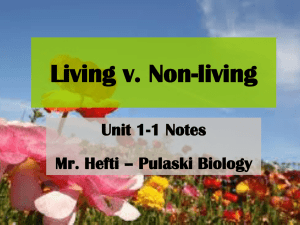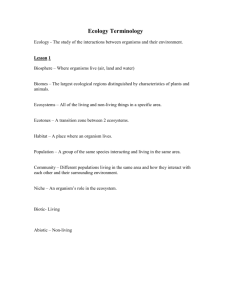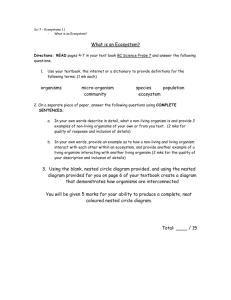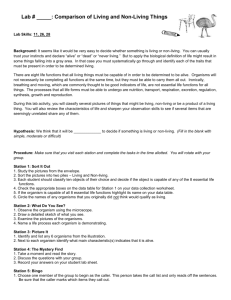Complexity in living and non
advertisement
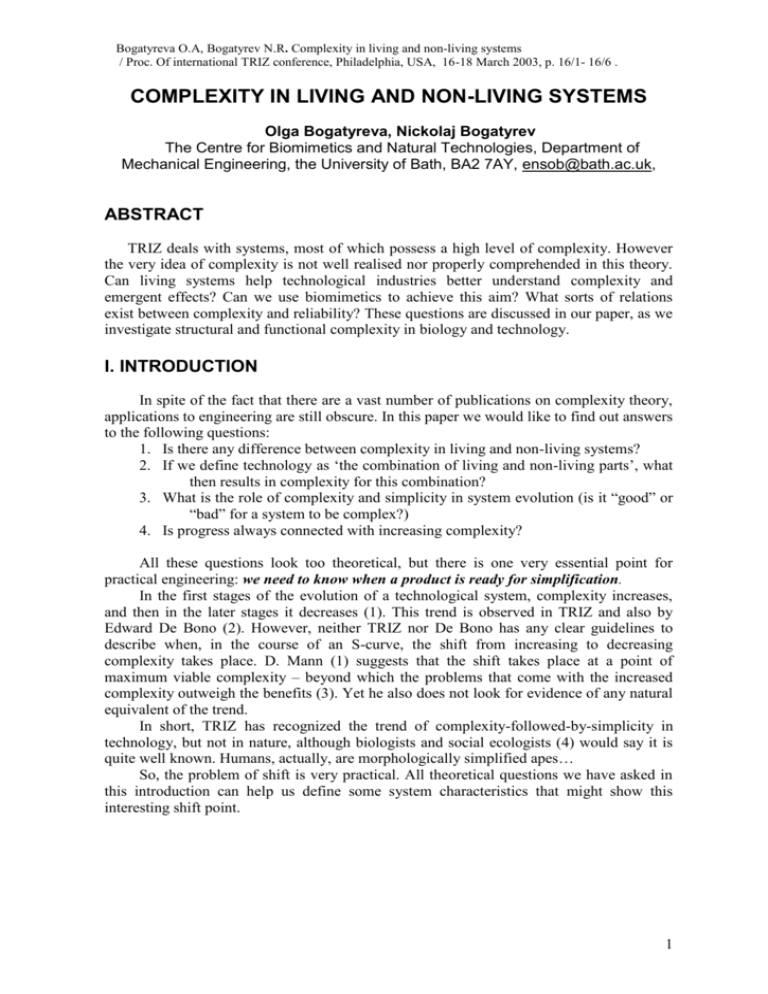
Bogatyreva O.A, Bogatyrev N.R. Complexity in living and non-living systems / Proc. Of international TRIZ conference, Philadelphia, USA, 16-18 March 2003, p. 16/1- 16/6 . COMPLEXITY IN LIVING AND NON-LIVING SYSTEMS Olga Bogatyreva, Nickolaj Bogatyrev The Centre for Biomimetics and Natural Technologies, Department of Mechanical Engineering, the University of Bath, BA2 7AY, ensob@bath.ac.uk, ABSTRACT TRIZ deals with systems, most of which possess a high level of complexity. However the very idea of complexity is not well realised nor properly comprehended in this theory. Can living systems help technological industries better understand complexity and emergent effects? Can we use biomimetics to achieve this aim? What sorts of relations exist between complexity and reliability? These questions are discussed in our paper, as we investigate structural and functional complexity in biology and technology. I. INTRODUCTION In spite of the fact that there are a vast number of publications on complexity theory, applications to engineering are still obscure. In this paper we would like to find out answers to the following questions: 1. Is there any difference between complexity in living and non-living systems? 2. If we define technology as ‘the combination of living and non-living parts’, what then results in complexity for this combination? 3. What is the role of complexity and simplicity in system evolution (is it “good” or “bad” for a system to be complex?) 4. Is progress always connected with increasing complexity? All these questions look too theoretical, but there is one very essential point for practical engineering: we need to know when a product is ready for simplification. In the first stages of the evolution of a technological system, complexity increases, and then in the later stages it decreases (1). This trend is observed in TRIZ and also by Edward De Bono (2). However, neither TRIZ nor De Bono has any clear guidelines to describe when, in the course of an S-curve, the shift from increasing to decreasing complexity takes place. D. Mann (1) suggests that the shift takes place at a point of maximum viable complexity – beyond which the problems that come with the increased complexity outweigh the benefits (3). Yet he also does not look for evidence of any natural equivalent of the trend. In short, TRIZ has recognized the trend of complexity-followed-by-simplicity in technology, but not in nature, although biologists and social ecologists (4) would say it is quite well known. Humans, actually, are morphologically simplified apes… So, the problem of shift is very practical. All theoretical questions we have asked in this introduction can help us define some system characteristics that might show this interesting shift point. 1 Bogatyreva O.A, Bogatyrev N.R. Complexity in living and non-living systems / Proc. Of international TRIZ conference, Philadelphia, USA, 16-18 March 2003, p. 16/1- 16/6 . 2. COMPLEXITY IN LIVING AND NON-LIVING SYSTEMS There are five general features in the scientific definition of complexity (4,5): 1. Complex systems have closely connected parts. 2. Knowing behaviour of parts does not enable us to predict system behaviour. 3. Dynamical behaviour might be classified into ‘order’, ‘complexity’, ‘chaos’, and ‘randomness’. All these parts are not mutually exclusive (4). Complexity is somewhere in the middle between chaos and order. The phenomenon of life is typically complex. Nonliving systems are either in chaos or in order (5, 6, fig.1). 4. Complexity breaks symmetry (in a case of pre-existing order, it breaks ‘structural symmetry’, in the case of pre-existing chaos, ‘probability symmetry’) (6, fig.1). Fig. 1. Relative entropy of a system as an index of life definition where H – entropy of the system, Hmax – maximum entropy of the system. So, what is complexity? More or less, something that is difficult for us to understand and predict as a whole, without decomposition into parts. It is something at a scale of space and time that differs from our scale, and is thus difficult to imagine. For example, if it as big as the Universe or small as a cell, it is difficult to describe, model and predict (fig.2 ). Likewise, when technical systems act on a similar scale with us, they seem to be simple, when they are bigger/too slow or smaller/too fast, they seem to be complex to understand. We always want to simplify technology, but is there ever a real simplification of it? Let us take an example from D. Mann’s paper in TRIZ-journal (1) about a strip with the ‘shape change with temperature’ function. First it was bi-metallic and there were three or more components (the two different metals plus some intermediary agent to bond the two together). Then the function of the bi-metallic strip was delegated to a ‘single’ shapememory alloy. But the overall ‘complexity’ of the system did not decrease. It has instead 2 Bogatyreva O.A, Bogatyrev N.R. Complexity in living and non-living systems / Proc. Of international TRIZ conference, Philadelphia, USA, 16-18 March 2003, p. 16/1- 16/6 . been subsumed into the sub-system structure of the constituent parts that is far from our “0” on time/space scale (fig.2). In other words, although a shape-memory alloy replaces three or two parts with one, it has largely done so through clever configuration of the crystal structure of the alloy – and as such, the complexity has been transferred from the engineer to the materials scientist (1). Fig. 2. Complexity in man space/time scale. It means that all technology simplification has sense only on that “point” of time/space scale that we can comprehend. And all simplification in technology evolution is nothing but delegating all complexity to sub-systems level. In other words, the ideal result is something that works, but we cannot see how. Fig. 3. Complexity and simplicity in living systems development. Defining of shift points from complexity to simplicity. LS – living systems, N/LS – non-living systems, T/S – technological system, IFR – ideal final result 3 Bogatyreva O.A, Bogatyrev N.R. Complexity in living and non-living systems / Proc. Of international TRIZ conference, Philadelphia, USA, 16-18 March 2003, p. 16/1- 16/6 . Let us have a look at living systems. Do they develop towards complexity? Increasing complexity in living systems is always connected with the necessity of saving its wholeness. When a system is too complex to maintain itself, it comes to a shift point – to simplify functioning of its elements or to die. Such functional simplification in biology is a specialisation. We estimated these shift points by the index of relative entropy studying evolution of societies in social insects, apes and humans (5, fig.3). Trends of evolution and ideal final results of living, non-living and technical systems are different (fig3). Life tends to grow and spread in space and time (IFR for LS), but this is possible only with its functional simplification (specialisation), otherwise there will not be enough resources on Earth. Ideal final result for non-living systems (IFR for N/LS) is structural and functional simplification (entropy increasing), while technology evolves in the opposite direction to life systems – ideal final result for any technical device is structural simplification but functional complexity (fig.3). So, technology, when it imitates living systems, comes to highly-specialised, complex products. Paths of biological and technical evolution are different and biological evolution is not suitable for imitation in technology if we need simple poly-functional (high adaptable) products. But if technology has a goal of creating artificial life, or life-like systems (sustainable and autonomous) (fig.1), it probably needs to change its ideal final result and evolve towards a structural complexity combining with functional simplification of its elements. Apart from functional and structural complexity there is “organisational” (algorithmic) complexity – complexity of interactions (connections) between sub-systems, rules of system behaviour (table. 1). Simple Complex Structure (“hard-ware” of a system) Table 1. Complexity in “soft-ware” and “hard-ware” of a system Examples from Biology Rules, algorithm (“soft-ware” of a system) Simple Complex Bacteria, Protozoa Behavioural hierarchy Technology Thermometer Flute Biology Blood system Ecosystem Technology Cellular automata Internet 3. COMPLEXITY AND RELIABILITY. Complexity is often discussed in connection with system reliability or sustainability. Both structurally complex and simple systems can be reliable or non-reliable. For example, simple and reliable is hand hammer, but simple and non-reliable can be any disposal product. Natural ecosystems are complex and reliable, but complex artificial ecosystems are not reliable. Reliability can be provided by system “hardware”: structural surplus (extra-strength of dams, bridges); functional surplus (multifunctional devices) 4 Bogatyreva O.A, Bogatyrev N.R. Complexity in living and non-living systems / Proc. Of international TRIZ conference, Philadelphia, USA, 16-18 March 2003, p. 16/1- 16/6 . and “software”: adaptability; integration. Reliability can only be achieved if every element of a system performs several functions and any function of a system is supported by several structures (7). But what does it mean – “several”, how many is enough for system reliability? System reliability can vary depending on particular parameters. For example, a system can be very reliable in resistance to wear, but non-reliable in functioning… Adaptability, on the other hand, should not damage integrity. The system is reliable when it’s relative entropy index is in the “corridor” of distribution of integrity parameter of its parts (fig. 2, 3). Artificial/technical systems do not need exact copying of natural prototypes. The right strategy is to take the best features of living systems and to get rid of the weakest sides of them. Advantages of non-living nature and living nature should be combined. The shortcoming of biological systems is complexity, and the weakest link of non-living systems is simple (primitive) functioning. Combinations of complex functioning (poly- functionality senso lato) of living and structural simplicity of non-living systems would provide the desirable character (ideal final result) of the future technologies. CONCLUSIONS. 1. 2. 3. 4. Complexity of any system is connected with their stochastic behaviour and selforganisation, the number of their parts and number of functional connections between them. But complexity of living and mixed (living + non-living) technological systems has some peculiarities. Non-living systems display goal-directed behaviour, while living systems have goal intended behaviour and free will. It makes them unpredictable and complex. Technical systems are usually deterministic ones. In technical systems probability cannot be the indicator of complexity (imagine a car engine that works with 80% probability!) Either in living nature or in technology, increasing complexity is connected with simplification of its sub-system. Complexity and simplicity in the course of evolution just changes their place in “System Operator”. Simplifying the system structure, we increase sub-system complexity. REFERENCES: Mann D.L. Complexity Increases And Then… TRIZ Journal, 2002. De Bono E., ‘Simplicity’, Viking, London, 1998. Mann D.L. Hands-On Systematic Innovation, CREAX Press, April 2002. Williams G.P. Chaos Theory Tamed. Joseph Henry Press, Washington, D.C., 1997 Bogatyreva O.A., Shillerov A.E. Social Synergetics. Novosibirsk, “Nauka”, 1998. Pavard B., Dugdale J. An Introduction to Complexity in Social Science. GRICIRIT, Toulouse, France,2002. 7. Mollison B. Permaculture: a designer’s manual. Tyalgum. – Tagary Publications, NSW 2484, Australia, 1998. 1. 2. 3. 4. 5. 6. 5



